Madhuri Bhaduri’s career spanning over four decades started with national-level badminton and squash, going on to an illustrious journey in art. She talks about the evolution of her work from figurative to abstract, and the evolution of the art-world, in an interview with Sonalee Tomar.
You don’t have to chase mountains, when the mountain comes to you is easier. What is power? It is not a noun, but a verb. It only exists when you exercise it. Power as a word is inert and dysfunctional if you don’t exert it with your actions.
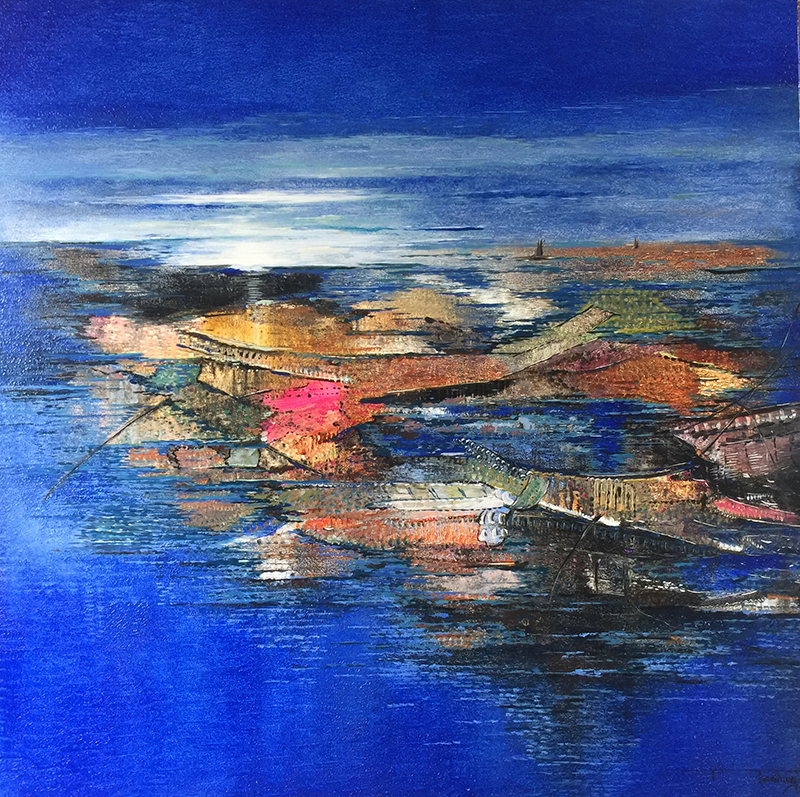
Seascape. Contemporary artist Madhuri Bhaduri.

Solo show Jehangir, Mumbai Contemporary artist Madhuri Bhaduri (left) with Pheroza Godrej (right).

Contemporary artist Madhuri Bhaduri (left). Jai Vakeel Foundation’s Champions of Change, a multi artist exhibit curated by Arzan Khambatta on the occasion of the 75th anniversary of Jai Vakeel at the Tao art gallery, Mumbai.
Take us to the beginning of your story.
My mom was a classical singer and dad was a national-level sportsperson. He wanted me to sing too, but I was born with a badminton racket. Following in his footsteps, I played Badminton Nationals quite early in life, just like him. Then I played squash, while studying Economics in 1978 before turning my attention to art. In fact, my mother gave away my cups and medals to the kabadiwala, so no real record of it exists. This was back in the day before all the technological innovations in media and documentation. I built my first studio in 1999, and thanks to a new double-height studio wall, I started thinking in 3D. My tryst with sculpture began in 2000. It was a scrap metal piece, made in collaboration with the late Vijay Shinde. Furniture and fabrics followed later. Today, it has been 20 years of fibre glass and scrap metal work.
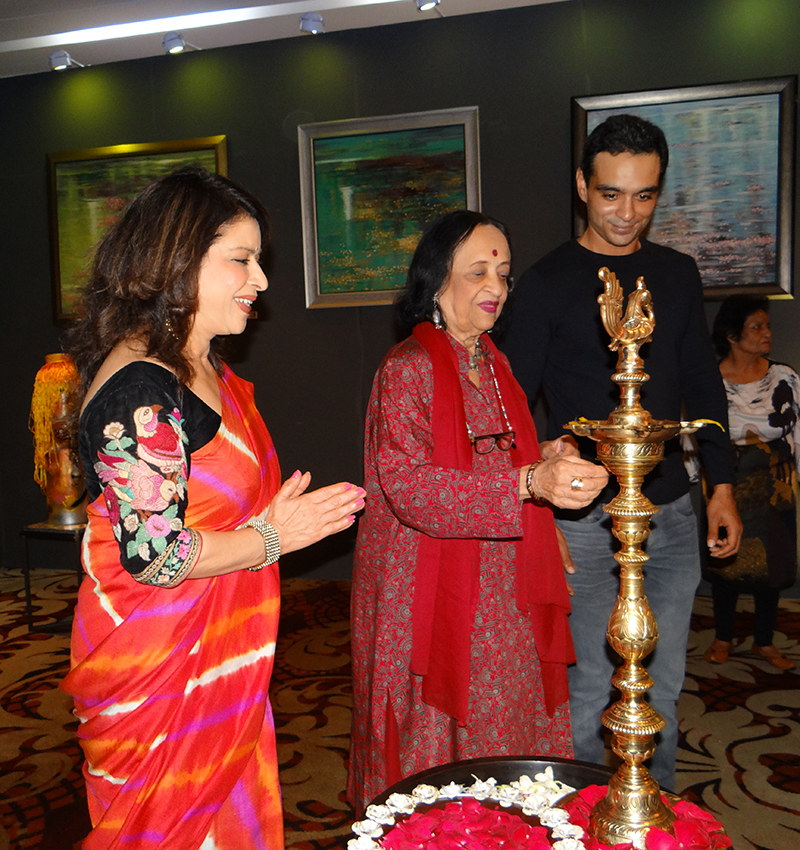
Contemporary artist Madhuri Bhaduri (left). Lighting the lamp atthe 40th solo show by Padmashree Anjolie Ela Menon

Contemporary artist Madhuri Bhaduri with the legendary actor Amitabh Bachchan at a badminton tournament in 1975.
You’ve come a long way since your first show, what were some of the pivotal moments?
My career has spanned over 40 years and the most interesting bits are yet to come. The inspiration and subject of my work were nature related till the 90s. In 1991, I had a pivotal solo show at the Jahangir Art Gallery. This was mostly figurative work. I did Indian figuratives, fashion, nudes, clowns and architectural paintings till the 2000’s. A visit to the abandoned fishing village and boatyard in Harne lead to a series of paintings featuring fisherwomen.

Contemporary artist Madhuri Bhaduri (left). Padmashree Sunita Kohli is an Indian interior designer, architectural restorer and furniture manufacturer. She had restored and decorated Rashtrapati Bhavan, Parliament House Colonnade, the Prime Minister’s Office and Hyderabad House in New Delhi.

My most memorable early encouragement came from Maharani Gayatri Devi in the late 70s and Jamshed Ji Baba, Tata Sons in the early 80s.
Contemporary artist Madhuri Bhaduri
Tell us about the evolution of your practice over the years and your commitment to abstraction.
The first abstract show in 2002 was pivotal for me. It was the evolution of my figurative work. It has been a long abstract journey since the first show as my work remains grounded in the same inspirations of nature. Figurative art is the surface level story. And once I got into the core of the subject, it lead to me making abstract reflections of the same topics I did before in figurative style.
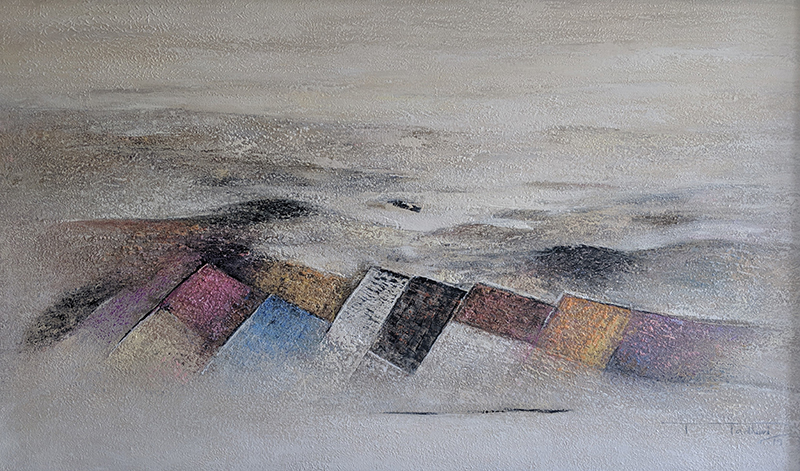
Horizons. Contemporary artist Madhuri Bhaduri.
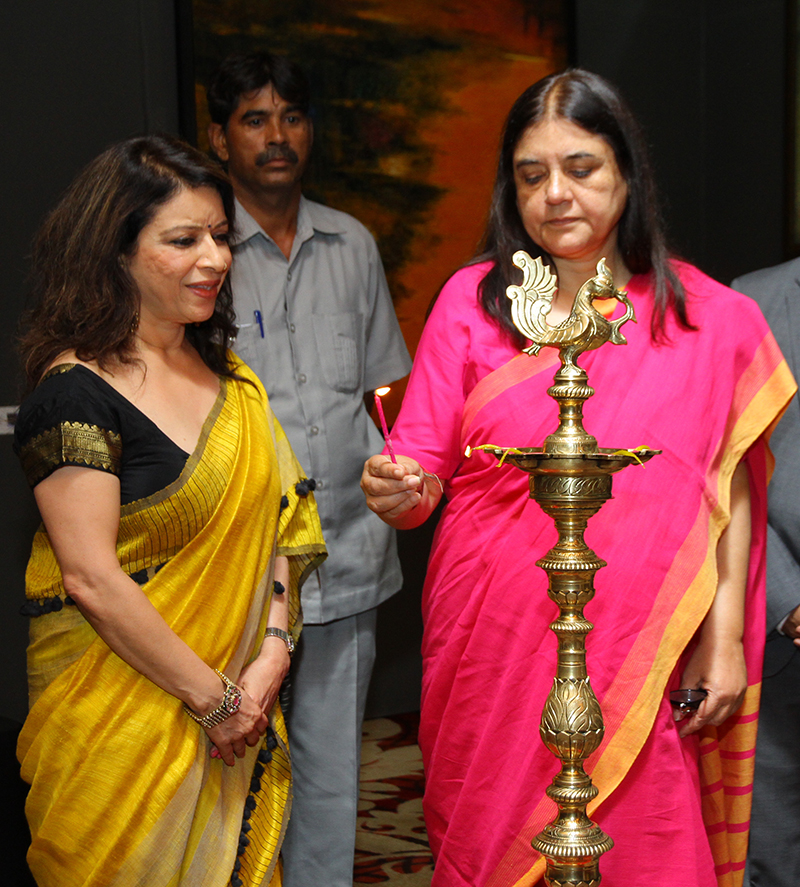
Lighting the lamp by Smt. Contemporary artist Madhuri Bhaduri (left). Maneka Sanjay Gandhi (right).
What inspires your process? Take us through your frameworks.
I am inspired by the likes of Paul Klee and Van Gogh, but I am self-motivated, committed to my work and the medium of oil. Vivacious colours. Play of light. Interwoven factor of colours when it turns into texture. Blue and yellow. My early life as a sportsperson gave me the grounding that forms the foundation of my core. Three years of squash, badminton nationals, while studying economics, french and then art. Everything together made me who I am today; my education gave me the skills, which I have constantly upgraded. I am probably one of the few artists who has a complete record of all her work ever made, shown and sold; this is the discipline that I imbibed from sports.

Contemporary artist Madhuri Bhaduri (left). Jai Vakeel Foundation’s Champions of Change, a multi artist exhibit curated by Arzan Khambatta on the occasion of the 75th anniversary of Jai Vakeel at the Tao art gallery, Mumbai.
What is the primary role of an artist? How do you describe yourself in the context of challenging people’s perspectives via your work and art?
There is an interesting duality in my work, such that I am always working on contradictory and separate elements in the 2D and 3D works. It is like the opposite blacks and whites of a Gemini mind. Everything moves ahead in twos. My works in sculpture are figurative, but my 2D paintings are increasingly abstract. I love analyzing the mind, and applying my education in economics to psychology. I had done a course in Eco-psycho Social Economics in 1978.

Contemporary artist Madhuri Bhaduri (centre). Studio visit by friend Sanjay Kohli and charming Mr. Mohammed Alardhi, Chairman of Investcorp with his team from London.
How do you deal with the conceptual difficulty and uncertainty of creating a new show?
Power equals the ability to use a share or improve. A person like me who treasures and respects Independence in others, gives me the confidence. I believe power is only real when it is shared to help others.
Contemporary artist Madhuri Bhaduri
In college I studied only Economics, and didn’t do any art. I believe that I love the creative process because I am meant to use. My mind is childlike. One after another I seek newer experiences and ways of seeing things around me. This translates into my art. My personality and the functionality of doing my work – are intrinsically linked. I feel like I may end up feeling worthless if I don’t do something with myself. In my paintings, I tend to work from memory. I never need reference images. The nature, texture and treatment, changes according to the subject. From my first show to now, the subjects of my initial figurative art have remained the same, but my treatment and style increasingly turned visually abstract and finely tuned to light.
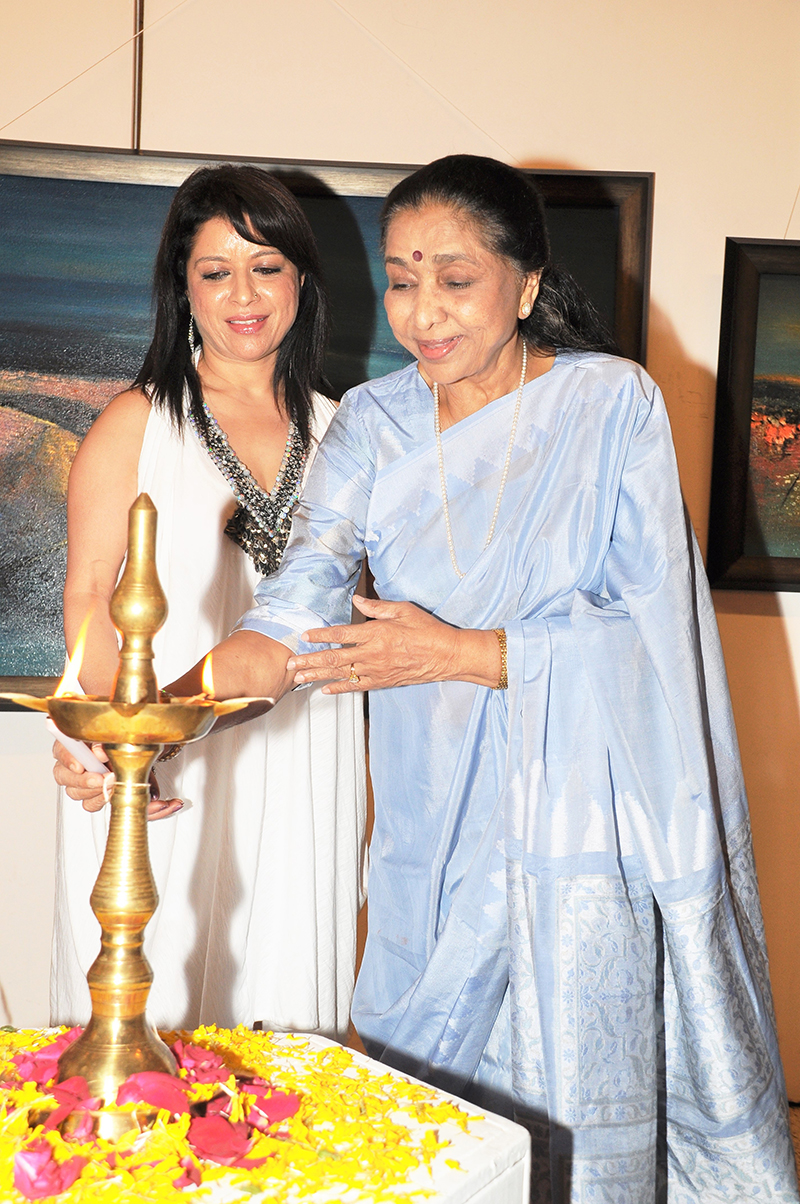
Contemporary artist Madhuri Bhaduri (left). Asha Bhosale (right) Inaugurated her solo show at Jenhangir Art Gallery, Mumbai in 2011.

Contemporary artist Madhuri Bhaduri with a guest at the ART PODium Singapore- an art fair of contemporary masterpieces from India and South-East Asia at the The Arts House at The Old Parliamen Singapore.
How does your audience interact and react to the work you put out into the world?
Once it is done, it’s just a memory. Once a piece is finished, I lose interest. I don’t mean to call my completed work an afterthought, because I do retain the joy of a maker, but at the same time I feel detached from it. The audience has spoken through their actions. I once sold 45 works out of 60 works displayed over 3 days. The exact reactions are hazy to me because I’m not dwelling in the past. I’m driven by what’s around the corner, towards the future, what I work on next. I feel positively about commissions as long as the only constraint is size.

A work in progress. Contemporary artist Madhuri Bhaduri. Artist’s palette in studio.
What trends have you observed in the art world? How do you foresee it evolving?
I did a Masters in Art History. When I applied for the Art Finance course at Sotheby’s, they requested an Economics mark sheet for the course. There were a couple of gallerists amongst the other students, but apart from them were mostly young professionals tired of finance and dabbling in art, following a trend of sorts. There I didn’t even share my age with anyone and I suppose they didn’t guess. As a part of the final exam, two art objects had to be assessed, researched and evaluated. I chose a Raza. I realized he’s the only one whose work has been documented because he was in Paris and so there are records! We don’t have a culture of keeping records in India. This is something I have incorporated into my practice.
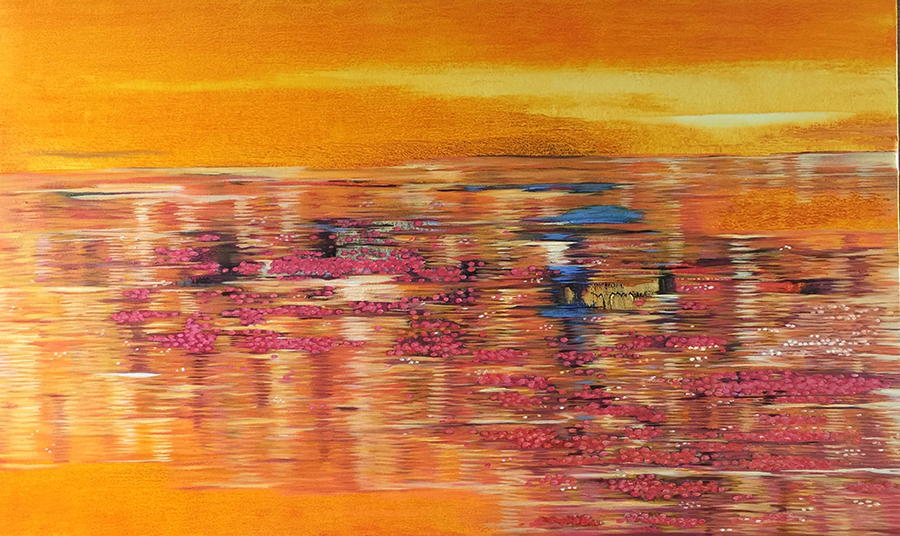
You’ve spent a lot of time amongst artists in flow. What have you observed?
Art is an expression of yourself. It creates a purpose for you. You don’t have to create a purpose for the art
The old masters, like the Razas and the Hussains made art for the joy of it. Just like them, engaging in the process of creating my work gives me purpose.
What are you working on?
A solo show on the 8th of February, focusing on the New Moon series.
Before you go – you might like to browse our Artist Interviews. Interviews of artists and outliers on how to be an artist. Contemporary artists on the source of their creative inspiration.








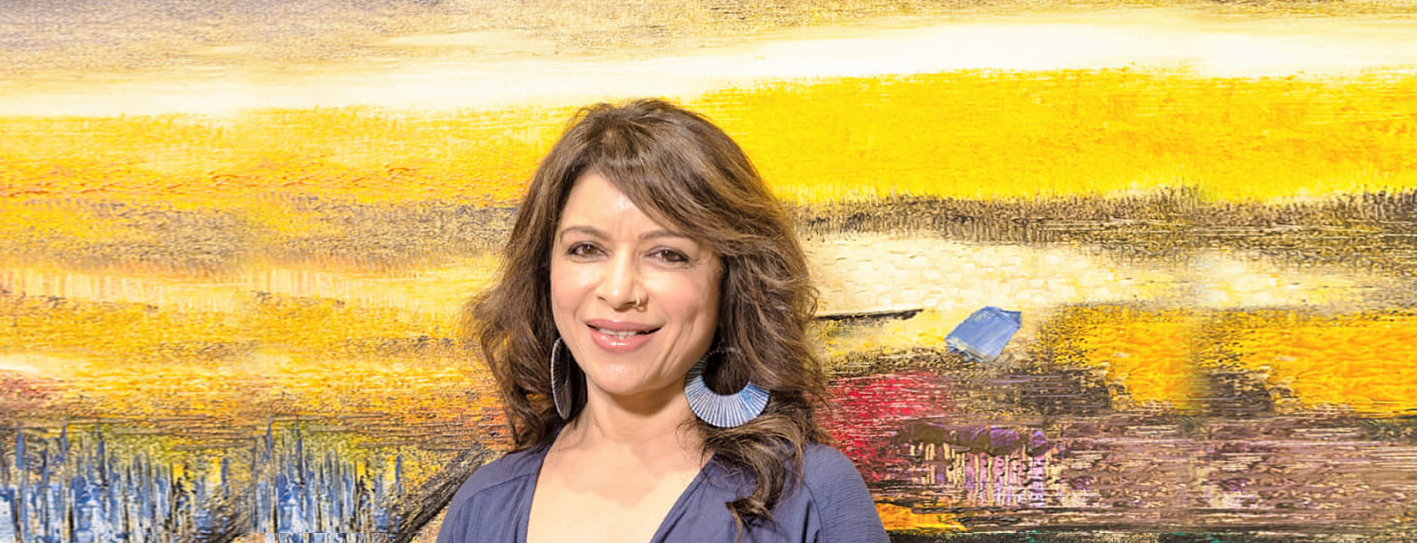



Add Comment